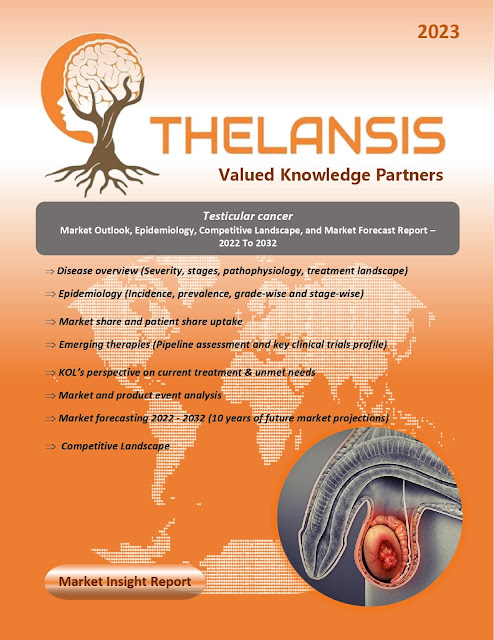Testicular Cancer – Market Outlook, Epidemiology, Competitive Landscape, and Market Forecast Report – 2022 To 2032
Testicular cancer, which primarily affects men between the ages of 15 and 45, is the most prevalent form of malignancy within this age group. When promptly identified and treated using a multimodal approach, it represents one of the most frequently curable types of cancer. Testicular cancer comprises approximately 1% of male tumors and 5% of urological malignancies. Epidemiological risk factors include cryptorchidism (undescended testicles), impaired spermatogenesis leading to sub- or infertility, disorders of sexual development, a family history of testicular tumors among first-degree relatives, and the presence of a contralateral tumor or germ-cell neoplasia in-situ (GCNIS). Genetic alterations have been identified as significant risk factors in the etiology of testicular cancer. The presence of the isochromosome of the short arm of chromosome 12 (i12p) is a characteristic feature of all types of adult germ cell tumors (GCTs) and GCNIS. Approximately 66% of GCNIS cases exhibit abnormalities in the p53 gene. Moreover, genetic polymorphisms in the PTEN tumor suppressor gene have been associated with an increased risk of testicular cancer. Dysregulation of the pluripotent program of fetal germ cells, indicated by markers M2A, C-KIT, and OCT4/NANOG, is believed to contribute to developing GCNIS and germ cell neoplasia. The most common presentation of testicular cancer is a painless mass, although up to 45% of patients may experience testicular pain, with 25% exhibiting signs and symptoms resembling acute epididymitis. Symptoms indicative of metastatic disease, such as back pain, dyspnea, and gynecomastia resulting from the production of HCG by malignant tumors, are less frequently observed. Complications associated with testicular malignancy can be broadly categorized into two groups: those stemming from the disease and those arising from its treatment. Disease-related complications encompass chronic fatigue, anxiety disorders, metastatic complications, and venous thromboembolism. Treatment-related complications include hypogonadism, which can lead to depression, sexual dysfunction, reduced physical well-being, peripheral neuropathy (associated with cisplatin use), and hearing loss (associated with cisplatin use). The average age at initial diagnosis of testicular cancer is approximately 33 years. While the disease predominantly affects young and middle-aged men, around 6% of cases occur in children and teenagers, and approximately 8% occur in men over 55.
·
The annual incidence of testicular cancer in
the United States is 5.6 cases per 1 million population.
Thelansis’s “Testicular Cancer Market
Outlook, Epidemiology, Competitive Landscape, and Market Forecast Report – 2022
To 2032" covers disease overview, epidemiology, drug utilization,
prescription share analysis, competitive landscape, clinical practice,
regulatory landscape, patient share, market uptake, market forecast, and key
market insights under the potential Testicular Cancer treatment modalities
options for eight major markets (USA, Germany, France, Italy, Spain, UK, Japan,
and China).
KOLs insights
of Testicular Cancer across 8 MM market from the centre of Excellence/ Public/
Private hospitals participated in the study. Insights around current treatment
landscape, epidemiology, clinical characteristics, future treatment paradigm,
and Unmet needs.
Testicular Cancer Market Forecast Patient
Based Forecast Model (MS. Excel Based Automated Dashboard), which Data Inputs
with sourcing, Market Event, and Product Event, Country specific Forecast
Model, Market uptake and patient share uptake, Attribute Analysis, Analog
Analysis, Disease burden, and pricing scenario, Summary, and Insights.
Thelansis Competitive Intelligence (CI) practice
has been established based on a deep understanding of the pharma/biotech
business environment to provide an optimized support system to all levels of
the decision-making process. It enables business leaders in forward-thinking
and proactive decision-making. Thelansis supports scientific and commercial
teams in seamless CI support by creating an AI/ ML-based technology-driven
platform that manages the data flow from primary and secondary sources.




Comments
Post a Comment